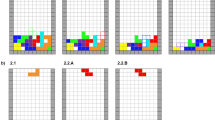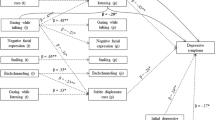Abstract
This study explored the hypothesis that siblings display a tendency for family resemblance in nonverbal decoding skills. Thirty-seven sibling pairs between the ages of 9 and 15 were administered the videotaped Nonverbal Discrepancy Test. This audiovisual test assesses (1) decoding accuracy—the extent to which subjects are able to identify affects (positivity and dominance) from face, body, and tone of voice cues; (2) discrepancy accuracy—the extent to which subjects recognize the degree of discrepancy between audio and video cues; and (3) video primacy—the extent to which subjects are more influenced by video (face or body) than by audio cues. Brother-brother pairs showed family resemblances in all three nonverbal indices, whereas brother-sister pairs displayed family similarity only in discrepancy accuracy. Overall, sibling pairs showed a tendency for family resemblance in nonverbal decoding. The processes that might lead siblings to develop similar patterns of nonverbal skills were discussed.
Similar content being viewed by others
References
Bowerman, C. E., & Dobash, R. M. Structural variation in intersibling affect.Journal of Marriage and the Family 1974,36 48–54.
Charlesworth, W. R., & Kreutzer, M. A. Facial expressions of infants and children. In P. Ekman (Ed.),Darwin and facial expression. New York: Academic Press, 1973.
DePaulo, B. M., & Rosenthal, R. The structure of nonverbal decoding skills.Journal of Personality 1979,47 506–517.
DePaulo, B. M., Rosenthal, R., Eisenstat, R. A., et al. Decoding discrepant nonverbal cues.Journal of Personality and Social Psychology 1978,36 313–323.
DePaulo, B. M., Rosenthal, R., Finkelstein, S., & Eisenstat, R. A. The developmental priority of the evaluative dimension in perceptions of nonverbal cues.Environmental Psychology and Nonverbal Behavior 1979,3 164–171.
Munsinger, H. & Douglass A., II. The syntactic abilities of identical twins, fraternal twins, and their siblings.Child Development 1976,47 40–50.
Rogers, P. L., Scherer, K. R., & Rosenthal, R. Content-filtering human speech.Behavioral Research Methods and Instrumentation 1971,3 16–18.
Rosenthal, R., Hall, J. A., DiMatteo, M. R., et al.Sensitivity to nonverbal communication: The PONS Test. Baltimore: The Johns Hopkins University Press, 1979.
Scherer, K. R. Randomized-Splicing: A note on a simple technique for masking speech content.Journal of Experimental Research in Personality 1971,5 155–159.
Snedecor, G. W., & Cochran, W. G.Statistical methods. Ames: Iowa State University Press, 1967.
Zuckerman, M., & Przewuzman, S. J. Decoding and encoding facial expressions in pre-school children.Environmental Psychology and Nonverbal Behavior 1979,3 147–163.
Zuckerman, M., Blanck, P. D., DePaulo, B. M., & Rosenthal, R. Developmental changes in decoding discrepant and nondiscrepant nonverbal cues. Developmental Psychology 1980,3, in press.
Author information
Authors and Affiliations
Rights and permissions
About this article
Cite this article
Blanck, P.D., Zuckerman, M., DePaulo, B.M. et al. Sibling resemblances in nonverbal skill and style. J Nonverbal Behav 4, 219–226 (1980). https://doi.org/10.1007/BF00986198
Issue Date:
DOI: https://doi.org/10.1007/BF00986198




